Home / Reagent Friday: Potassium tert-butoxide [KOC(CH3)3]
Organic Reagents
Reagent Friday: Potassium tert-butoxide [KOC(CH3)3]
Last updated: March 26th, 2025 |
Potassium tert-Butoxide (KOt-Bu) Is A Bulky Base
In a blatant plug for the Reagent Guide and the Reagents App for iPhone, each Friday I profile a different reagent that is commonly encountered in Org 1/ Org 2.

Sometime back in general chemistry you (hopefully) learned that hydroxide ion (HO-) is a strong base. It’s the conjugate base of water – that is to say, that’s what’s left behind once we’ve ripped a proton (H+) off of it. Likewise, alcohols (ROH) are strong bases too – once you remove the proton to get the conjugate base (RO-). Similar in strength to the hydroxide ion, these are called alkoxides.
Potassium tert-Butoxide (KOt-Bu) Is A Bulky Base
Today’s reagent, potassium tert-butoxide (KOt-Bu), is a strong base just like all alkoxides, but there’s something about it that makes it special. If you’ve come across the tert-butyl group before, you should be able to remember one main thing: it’s really darn fat (although in these more sensitive times, “bulky” is the preferred nomenclature). And as the conjugate base of t-butanol, that makes t-butoxide a bulky base just like our old friend LDA. (Note that the “potassium” isn’t so crucial here and we can leave it out or replace it with sodium or lithium- it’s really the “t-butoxide” part we really care about.)
Potassium t-butoxide is like a really angry Sumo wrestler. It attacks things that are out in the open with fierce and sturdy determination. However, anything that requires the least bit of navigation through a narrow opening (like a doorway) is going to be difficult. In the chemical sense, this means that tert-butoxide is very sensitive to steric interactions. (What are “steric interactions” ? Think about 4 hungry Sumos trying to fit themselves around your tiny dinner table). More specifically, steric interactions are the repulsive interactions between electron clouds that happens when atoms “bump” into each other.
Potassium tert-Butoxide Is A Poorer Nucleophile Than Other Alkoxides Due To Steric Hindrance
So what does this mean for the chemical reactions of t-butoxide? Two things.
First, tert-butoxide is a poorer nucleophile than smaller alkoxides (like ethoxide, methoxide and so on) in nucleophilic substitution reactions (like the SN2). Why? Because the SN2 is very sensitive to steric interactions, and tert-butoxide is bulky.
As A Base, tert-Butoxide Tends To Favor The “Non-Zaitsev” of “Hofmann” Product In Elimination Reactions
- tert-butoxide can be used to form the “less substituted” alkenes in elimination reactions (the E2, specifically). Most of the time, elimination reactions favor the “more substituted” alkene – that is, the Zaitsev product. However, when tert-butoxide is used, it will preferentially remove the proton from the smaller group. This produces the so-called “Hoffmann” product. Let’s have a look.

Mechanism: Formation Of Alkenes Using tert-Butoxide As A Base
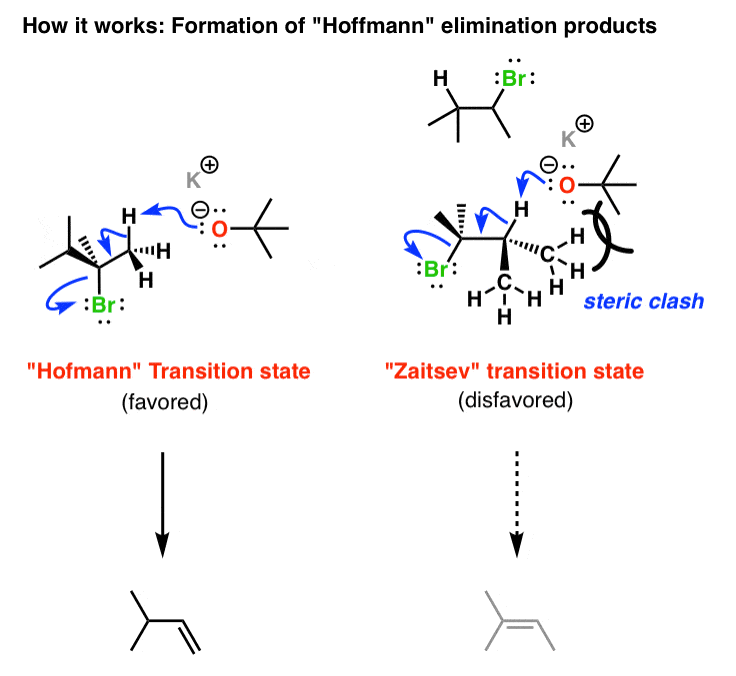
P.S. You can read about the chemistry of KOtBu and more than 80 other reagents in undergraduate organic chemistry in the “Organic Chemistry Reagent Guide”, available here as a downloadable PDF. The Reagents App is also available for iPhone, click on the icon below!
Quiz Yourself!
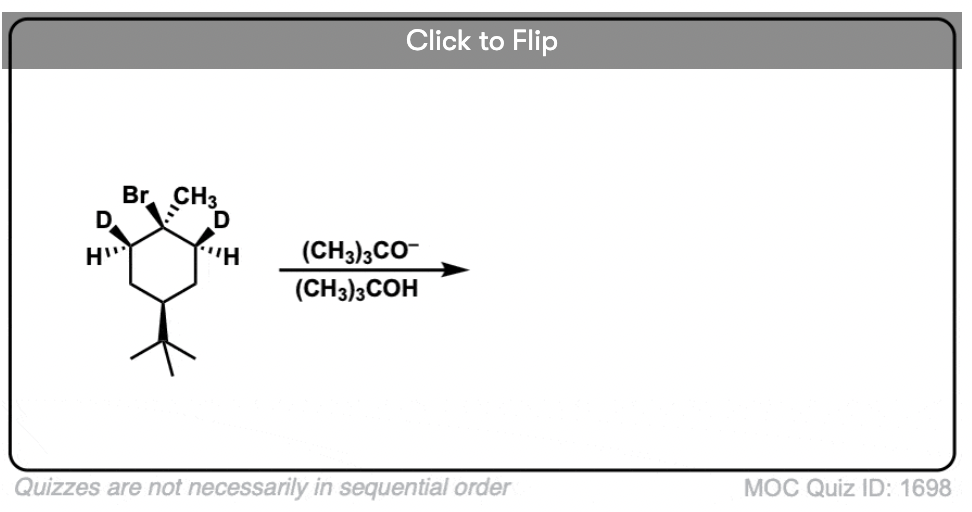
Become a MOC member to see the clickable quiz with answers on the back.
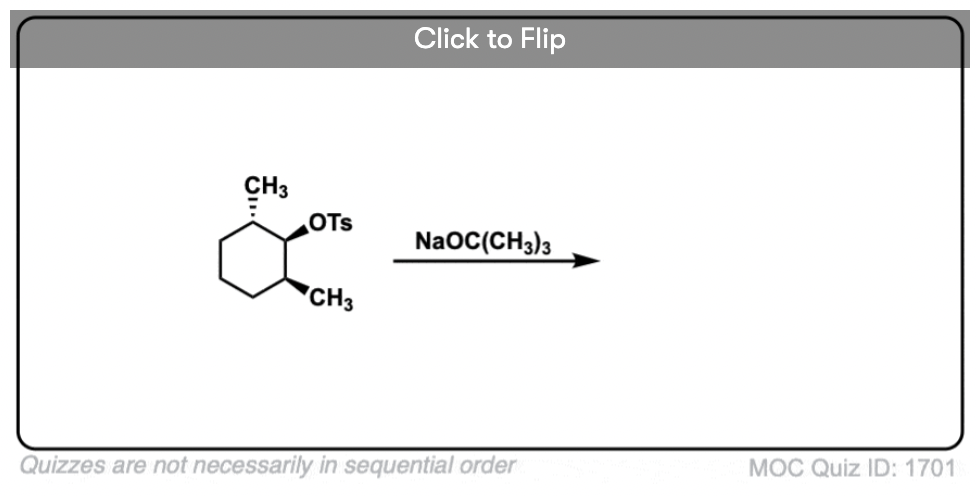
Become a MOC member to see the clickable quiz with answers on the back.
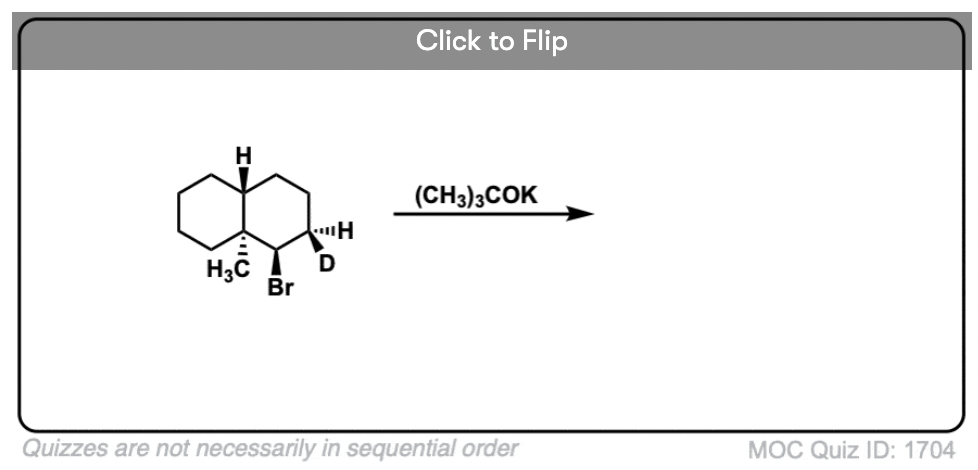
Become a MOC member to see the clickable quiz with answers on the back.
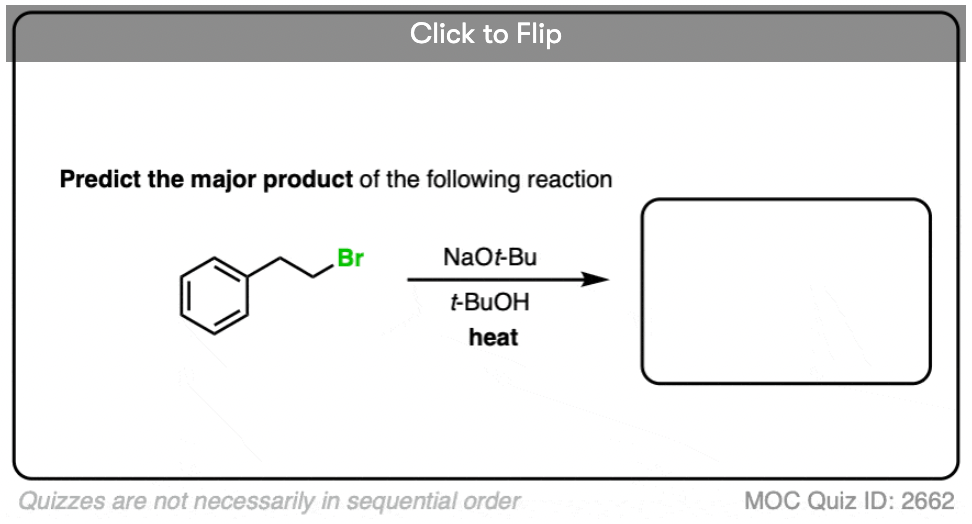
Become a MOC member to see the clickable quiz with answers on the back.
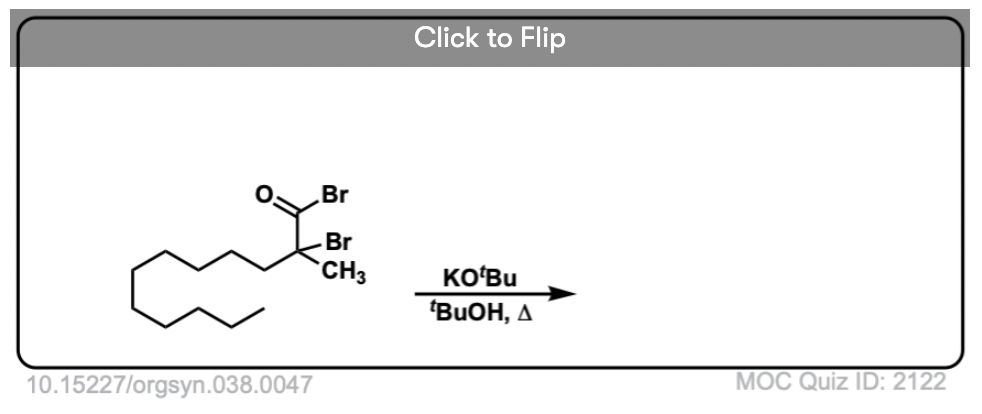
Become a MOC member to see the clickable quiz with answers on the back.
(Advanced) References And Further Reading
- Einwirkung der Wärme auf die Ammoniumbasen
W. Hofmann
Chem. Ber. 1881, 14 (1), 659-669
DOI: 10.1002/cber.188101401148
The original paper by W. Hofmann on a new method for olefin synthesis. He was a very productive organic chemist in the 19th century and his name has been attached to a variety of transformations, including amide degradation, isonitrile synthesis, and a few others.
- Olefins from Amines: The Hofmann Elimination Reaction and Amine Oxide Pyrolysis
Cope, Arthur C.; Trumbull, Elmer R.
React. 1960, 11, 317-493
DOI: 10.1002/0471264180.or011.05
Organic Reactions, published and maintained by the ACS division of Organic Chemistry, is a source of comprehensive reviews on various transformations in organic chemistry. This particular review is written by Prof. Cope (MIT, of the Cope rearrangement). Detailed experimental procedures are provided towards the end. - Hofmann-Type Elimination in the Efficient N-Alkylation of Azoles: Imidazole and Benzimidazole
András Horváth
Synthesis 1994; 1994 (1): 102-106
DOI: 1055/s-1994-25414
Alkylation of cyanoethyl-substituted azoles followed by heating with a strong base yields acrylonitrile via a Hofmann elimination. - Cyclization in the Course of Clarke—Eschweiler Methylation
Arthur C. Cope and W. Dickinson Burrows
The Journal of Organic Chemistry 1965 30 (7), 2163-2165
DOI:1021/jo01018a011
Two Hofmann eliminations are indicated in this paper, with compounds 5 and 7.
00 General Chemistry Review
01 Bonding, Structure, and Resonance
- How Do We Know Methane (CH4) Is Tetrahedral?
- Hybrid Orbitals and Hybridization
- How To Determine Hybridization: A Shortcut
- Orbital Hybridization And Bond Strengths
- Sigma bonds come in six varieties: Pi bonds come in one
- Dipole Moments and Dipoles
- A Key Skill: How to Calculate Formal Charge
- The Four Intermolecular Forces and How They Affect Boiling Points
- 3 Trends That Affect Boiling Points
- How To Use Electronegativity To Determine Electron Density (and why NOT to trust formal charge)
- Introduction to Resonance
- How To Use Curved Arrows To Interchange Resonance Forms
- Evaluating Resonance Forms (1) - The Rule of Least Charges
- How To Find The Best Resonance Structure By Applying Electronegativity
- Evaluating Resonance Structures With Negative Charges
- Evaluating Resonance Structures With Positive Charge
- Exploring Resonance: Pi-Donation
- Exploring Resonance: Pi-acceptors
- In Summary: Evaluating Resonance Structures
- Drawing Resonance Structures: 3 Common Mistakes To Avoid
- How to apply electronegativity and resonance to understand reactivity
- Bond Hybridization Practice
- Structure and Bonding Practice Quizzes
- Resonance Structures Practice
02 Acid Base Reactions
- Introduction to Acid-Base Reactions
- Acid Base Reactions In Organic Chemistry
- The Stronger The Acid, The Weaker The Conjugate Base
- Walkthrough of Acid-Base Reactions (3) - Acidity Trends
- Five Key Factors That Influence Acidity
- Acid-Base Reactions: Introducing Ka and pKa
- How to Use a pKa Table
- The pKa Table Is Your Friend
- A Handy Rule of Thumb for Acid-Base Reactions
- Acid Base Reactions Are Fast
- pKa Values Span 60 Orders Of Magnitude
- How Protonation and Deprotonation Affect Reactivity
- Acid Base Practice Problems
03 Alkanes and Nomenclature
- Meet the (Most Important) Functional Groups
- Condensed Formulas: Deciphering What the Brackets Mean
- Hidden Hydrogens, Hidden Lone Pairs, Hidden Counterions
- Don't Be Futyl, Learn The Butyls
- Primary, Secondary, Tertiary, Quaternary In Organic Chemistry
- Branching, and Its Affect On Melting and Boiling Points
- The Many, Many Ways of Drawing Butane
- Wedge And Dash Convention For Tetrahedral Carbon
- Common Mistakes in Organic Chemistry: Pentavalent Carbon
- Table of Functional Group Priorities for Nomenclature
- Summary Sheet - Alkane Nomenclature
- Organic Chemistry IUPAC Nomenclature Demystified With A Simple Puzzle Piece Approach
- Boiling Point Quizzes
- Organic Chemistry Nomenclature Quizzes
04 Conformations and Cycloalkanes
- Staggered vs Eclipsed Conformations of Ethane
- Conformational Isomers of Propane
- Newman Projection of Butane (and Gauche Conformation)
- Introduction to Cycloalkanes
- Geometric Isomers In Small Rings: Cis And Trans Cycloalkanes
- Calculation of Ring Strain In Cycloalkanes
- Cycloalkanes - Ring Strain In Cyclopropane And Cyclobutane
- Cyclohexane Conformations
- Cyclohexane Chair Conformation: An Aerial Tour
- How To Draw The Cyclohexane Chair Conformation
- The Cyclohexane Chair Flip
- The Cyclohexane Chair Flip - Energy Diagram
- Substituted Cyclohexanes - Axial vs Equatorial
- Ranking The Bulkiness Of Substituents On Cyclohexanes: "A-Values"
- Cyclohexane Chair Conformation Stability: Which One Is Lower Energy?
- Fused Rings - Cis-Decalin and Trans-Decalin
- Naming Bicyclic Compounds - Fused, Bridged, and Spiro
- Bredt's Rule (And Summary of Cycloalkanes)
- Newman Projection Practice
- Cycloalkanes Practice Problems
05 A Primer On Organic Reactions
- The Most Important Question To Ask When Learning a New Reaction
- Curved Arrows (for reactions)
- Nucleophiles and Electrophiles
- The Three Classes of Nucleophiles
- Nucleophilicity vs. Basicity
- What Makes A Good Nucleophile?
- What Makes A Good Leaving Group?
- 3 Factors That Stabilize Carbocations
- Equilibrium and Energy Relationships
- 7 Factors that stabilize negative charge in organic chemistry
- 7 Factors That Stabilize Positive Charge in Organic Chemistry
- What's a Transition State?
- Hammond's Postulate
- Learning Organic Chemistry Reactions: A Checklist (PDF)
06 Free Radical Reactions
- Free Radical Reactions
- 3 Factors That Stabilize Free Radicals
- Bond Strengths And Radical Stability
- Free Radical Initiation: Why Is "Light" Or "Heat" Required?
- Initiation, Propagation, Termination
- Monochlorination Products Of Propane, Pentane, And Other Alkanes
- Selectivity In Free Radical Reactions
- Selectivity in Free Radical Reactions: Bromination vs. Chlorination
- Halogenation At Tiffany's
- Allylic Bromination
- Bonus Topic: Allylic Rearrangements
- In Summary: Free Radicals
- Synthesis (2) - Reactions of Alkanes
- Free Radicals Practice Quizzes
07 Stereochemistry and Chirality
- Types of Isomers: Constitutional Isomers, Stereoisomers, Enantiomers, and Diastereomers
- How To Draw The Enantiomer Of A Chiral Molecule
- How To Draw A Bond Rotation
- Introduction to Assigning (R) and (S): The Cahn-Ingold-Prelog Rules
- Assigning Cahn-Ingold-Prelog (CIP) Priorities (2) - The Method of Dots
- Enantiomers vs Diastereomers vs The Same? Two Methods For Solving Problems
- Assigning R/S To Newman Projections (And Converting Newman To Line Diagrams)
- How To Determine R and S Configurations On A Fischer Projection
- The Meso Trap
- Optical Rotation, Optical Activity, and Specific Rotation
- Optical Purity and Enantiomeric Excess
- What's a Racemic Mixture?
- Chiral Allenes And Chiral Axes
- Stereochemistry Practice Problems and Quizzes
08 Substitution Reactions
- Nucleophilic Substitution Reactions - Introduction
- Two Types of Nucleophilic Substitution Reactions
- The SN2 Mechanism
- Why the SN2 Reaction Is Powerful
- The SN1 Mechanism
- The Conjugate Acid Is A Better Leaving Group
- Comparing the SN1 and SN2 Reactions
- Polar Protic? Polar Aprotic? Nonpolar? All About Solvents
- Steric Hindrance is Like a Fat Goalie
- Common Blind Spot: Intramolecular Reactions
- Substitution Practice - SN1
- Substitution Practice - SN2
09 Elimination Reactions
- Elimination Reactions (1): Introduction And The Key Pattern
- Elimination Reactions (2): The Zaitsev Rule
- Elimination Reactions Are Favored By Heat
- Two Elimination Reaction Patterns
- The E1 Reaction
- The E2 Mechanism
- E1 vs E2: Comparing the E1 and E2 Reactions
- Antiperiplanar Relationships: The E2 Reaction and Cyclohexane Rings
- Bulky Bases in Elimination Reactions
- Comparing the E1 vs SN1 Reactions
- Elimination (E1) Reactions With Rearrangements
- E1cB - Elimination (Unimolecular) Conjugate Base
- Elimination (E1) Practice Problems And Solutions
- Elimination (E2) Practice Problems and Solutions
10 Rearrangements
11 SN1/SN2/E1/E2 Decision
- Identifying Where Substitution and Elimination Reactions Happen
- Deciding SN1/SN2/E1/E2 (1) - The Substrate
- Deciding SN1/SN2/E1/E2 (2) - The Nucleophile/Base
- SN1 vs E1 and SN2 vs E2 : The Temperature
- Deciding SN1/SN2/E1/E2 - The Solvent
- Wrapup: The Key Factors For Determining SN1/SN2/E1/E2
- Alkyl Halide Reaction Map And Summary
- SN1 SN2 E1 E2 Practice Problems
12 Alkene Reactions
- E and Z Notation For Alkenes (+ Cis/Trans)
- Alkene Stability
- Alkene Addition Reactions: "Regioselectivity" and "Stereoselectivity" (Syn/Anti)
- Stereoselective and Stereospecific Reactions
- Hydrohalogenation of Alkenes and Markovnikov's Rule
- Hydration of Alkenes With Aqueous Acid
- Rearrangements in Alkene Addition Reactions
- Halogenation of Alkenes and Halohydrin Formation
- Oxymercuration Demercuration of Alkenes
- Hydroboration Oxidation of Alkenes
- m-CPBA (meta-chloroperoxybenzoic acid)
- OsO4 (Osmium Tetroxide) for Dihydroxylation of Alkenes
- Palladium on Carbon (Pd/C) for Catalytic Hydrogenation of Alkenes
- Cyclopropanation of Alkenes
- A Fourth Alkene Addition Pattern - Free Radical Addition
- Alkene Reactions: Ozonolysis
- Oxidative Cleavage of Vicinal Diols With NaIO4 and Pb(OAc)4
- Summary: Three Key Families Of Alkene Reaction Mechanisms
- Synthesis (4) - Alkene Reaction Map, Including Alkyl Halide Reactions
- Alkene Reactions Practice Problems
13 Alkyne Reactions
- Acetylides from Alkynes, And Substitution Reactions of Acetylides
- Partial Reduction of Alkynes With Lindlar's Catalyst
- Partial Reduction of Alkynes With Na/NH3 To Obtain Trans Alkenes
- Alkyne Hydroboration With "R2BH"
- Hydration and Oxymercuration of Alkynes
- Hydrohalogenation of Alkynes
- Alkyne Halogenation: Bromination and Chlorination of Alkynes
- Oxidation of Alkynes With O3 and KMnO4
- Alkenes To Alkynes Via Halogenation And Elimination Reactions
- Alkynes Are A Blank Canvas
- Synthesis (5) - Reactions of Alkynes
- Alkyne Reactions Practice Problems With Answers
14 Alcohols, Epoxides and Ethers
- Alcohols - Nomenclature and Properties
- Alcohols Can Act As Acids Or Bases (And Why It Matters)
- Alcohols - Acidity and Basicity
- The Williamson Ether Synthesis
- Ethers From Alkenes, Tertiary Alkyl Halides and Alkoxymercuration
- Alcohols To Ethers via Acid Catalysis
- Cleavage Of Ethers With Acid
- Epoxides - The Outlier Of The Ether Family
- Opening of Epoxides With Acid
- Epoxide Ring Opening With Base
- Making Alkyl Halides From Alcohols
- Tosylates And Mesylates
- PBr3 and SOCl2
- Elimination Reactions of Alcohols
- Elimination of Alcohols To Alkenes With POCl3
- Alcohol Oxidation: "Strong" and "Weak" Oxidants
- Demystifying The Mechanisms of Alcohol Oxidations
- Protecting Groups For Alcohols
- Thiols And Thioethers
- Calculating the oxidation state of a carbon
- Oxidation and Reduction in Organic Chemistry
- Oxidation Ladders
- SOCl2 Mechanism For Alcohols To Alkyl Halides: SN2 versus SNi
- Alcohol Reactions Roadmap (PDF)
- Alcohol Reaction Practice Problems
- Epoxide Reaction Quizzes
- Oxidation and Reduction Practice Quizzes
15 Organometallics
- What's An Organometallic?
- Formation of Grignard and Organolithium Reagents
- Organometallics Are Strong Bases
- Reactions of Grignard Reagents
- Protecting Groups In Grignard Reactions
- Synthesis Problems Involving Grignard Reagents
- Grignard Reactions And Synthesis (2)
- Organocuprates (Gilman Reagents): How They're Made
- Gilman Reagents (Organocuprates): What They're Used For
- The Heck, Suzuki, and Olefin Metathesis Reactions (And Why They Don't Belong In Most Introductory Organic Chemistry Courses)
- Reaction Map: Reactions of Organometallics
- Grignard Practice Problems
16 Spectroscopy
- Degrees of Unsaturation (or IHD, Index of Hydrogen Deficiency)
- Conjugation And Color (+ How Bleach Works)
- Introduction To UV-Vis Spectroscopy
- UV-Vis Spectroscopy: Absorbance of Carbonyls
- UV-Vis Spectroscopy: Practice Questions
- Bond Vibrations, Infrared Spectroscopy, and the "Ball and Spring" Model
- Infrared (IR) Spectroscopy: A Quick Primer On Interpreting Spectra
- IR Spectroscopy: 4 Practice Problems
- 1H NMR: How Many Signals?
- Homotopic, Enantiotopic, Diastereotopic
- Diastereotopic Protons in 1H NMR Spectroscopy: Examples
- 13-C NMR - How Many Signals
- Liquid Gold: Pheromones In Doe Urine
- Natural Product Isolation (1) - Extraction
- Natural Product Isolation (2) - Purification Techniques, An Overview
- Structure Determination Case Study: Deer Tarsal Gland Pheromone
17 Dienes and MO Theory
- What To Expect In Organic Chemistry 2
- Are these molecules conjugated?
- Conjugation And Resonance In Organic Chemistry
- Bonding And Antibonding Pi Orbitals
- Molecular Orbitals of The Allyl Cation, Allyl Radical, and Allyl Anion
- Pi Molecular Orbitals of Butadiene
- Reactions of Dienes: 1,2 and 1,4 Addition
- Thermodynamic and Kinetic Products
- More On 1,2 and 1,4 Additions To Dienes
- s-cis and s-trans
- The Diels-Alder Reaction
- Cyclic Dienes and Dienophiles in the Diels-Alder Reaction
- Stereochemistry of the Diels-Alder Reaction
- Exo vs Endo Products In The Diels Alder: How To Tell Them Apart
- HOMO and LUMO In the Diels Alder Reaction
- Why Are Endo vs Exo Products Favored in the Diels-Alder Reaction?
- Diels-Alder Reaction: Kinetic and Thermodynamic Control
- The Retro Diels-Alder Reaction
- The Intramolecular Diels Alder Reaction
- Regiochemistry In The Diels-Alder Reaction
- The Cope and Claisen Rearrangements
- Electrocyclic Reactions
- Electrocyclic Ring Opening And Closure (2) - Six (or Eight) Pi Electrons
- Diels Alder Practice Problems
- Molecular Orbital Theory Practice
18 Aromaticity
- Introduction To Aromaticity
- Rules For Aromaticity
- Huckel's Rule: What Does 4n+2 Mean?
- Aromatic, Non-Aromatic, or Antiaromatic? Some Practice Problems
- Antiaromatic Compounds and Antiaromaticity
- The Pi Molecular Orbitals of Benzene
- The Pi Molecular Orbitals of Cyclobutadiene
- Frost Circles
- Aromaticity Practice Quizzes
19 Reactions of Aromatic Molecules
- Electrophilic Aromatic Substitution: Introduction
- Activating and Deactivating Groups In Electrophilic Aromatic Substitution
- Electrophilic Aromatic Substitution - The Mechanism
- Ortho-, Para- and Meta- Directors in Electrophilic Aromatic Substitution
- Understanding Ortho, Para, and Meta Directors
- Why are halogens ortho- para- directors?
- Disubstituted Benzenes: The Strongest Electron-Donor "Wins"
- Electrophilic Aromatic Substitutions (1) - Halogenation of Benzene
- Electrophilic Aromatic Substitutions (2) - Nitration and Sulfonation
- EAS Reactions (3) - Friedel-Crafts Acylation and Friedel-Crafts Alkylation
- Intramolecular Friedel-Crafts Reactions
- Nucleophilic Aromatic Substitution (NAS)
- Nucleophilic Aromatic Substitution (2) - The Benzyne Mechanism
- Reactions on the "Benzylic" Carbon: Bromination And Oxidation
- The Wolff-Kishner, Clemmensen, And Other Carbonyl Reductions
- More Reactions on the Aromatic Sidechain: Reduction of Nitro Groups and the Baeyer Villiger
- Aromatic Synthesis (1) - "Order Of Operations"
- Synthesis of Benzene Derivatives (2) - Polarity Reversal
- Aromatic Synthesis (3) - Sulfonyl Blocking Groups
- Birch Reduction
- Synthesis (7): Reaction Map of Benzene and Related Aromatic Compounds
- Aromatic Reactions and Synthesis Practice
- Electrophilic Aromatic Substitution Practice Problems
20 Aldehydes and Ketones
- What's The Alpha Carbon In Carbonyl Compounds?
- Nucleophilic Addition To Carbonyls
- Aldehydes and Ketones: 14 Reactions With The Same Mechanism
- Sodium Borohydride (NaBH4) Reduction of Aldehydes and Ketones
- Grignard Reagents For Addition To Aldehydes and Ketones
- Wittig Reaction
- Hydrates, Hemiacetals, and Acetals
- Imines - Properties, Formation, Reactions, and Mechanisms
- All About Enamines
- Breaking Down Carbonyl Reaction Mechanisms: Reactions of Anionic Nucleophiles (Part 2)
- Aldehydes Ketones Reaction Practice
21 Carboxylic Acid Derivatives
- Nucleophilic Acyl Substitution (With Negatively Charged Nucleophiles)
- Addition-Elimination Mechanisms With Neutral Nucleophiles (Including Acid Catalysis)
- Basic Hydrolysis of Esters - Saponification
- Transesterification
- Proton Transfer
- Fischer Esterification - Carboxylic Acid to Ester Under Acidic Conditions
- Lithium Aluminum Hydride (LiAlH4) For Reduction of Carboxylic Acid Derivatives
- LiAlH[Ot-Bu]3 For The Reduction of Acid Halides To Aldehydes
- Di-isobutyl Aluminum Hydride (DIBAL) For The Partial Reduction of Esters and Nitriles
- Amide Hydrolysis
- Thionyl Chloride (SOCl2) And Conversion of Carboxylic Acids to Acid Halides
- Diazomethane (CH2N2)
- Carbonyl Chemistry: Learn Six Mechanisms For the Price Of One
- Making Music With Mechanisms (PADPED)
- Carboxylic Acid Derivatives Practice Questions
22 Enols and Enolates
- Keto-Enol Tautomerism
- Enolates - Formation, Stability, and Simple Reactions
- Kinetic Versus Thermodynamic Enolates
- Aldol Addition and Condensation Reactions
- Reactions of Enols - Acid-Catalyzed Aldol, Halogenation, and Mannich Reactions
- Claisen Condensation and Dieckmann Condensation
- Decarboxylation
- The Malonic Ester and Acetoacetic Ester Synthesis
- The Michael Addition Reaction and Conjugate Addition
- The Robinson Annulation
- Haloform Reaction
- The Hell–Volhard–Zelinsky Reaction
- Enols and Enolates Practice Quizzes
23 Amines
- The Amide Functional Group: Properties, Synthesis, and Nomenclature
- Basicity of Amines And pKaH
- 5 Key Basicity Trends of Amines
- The Mesomeric Effect And Aromatic Amines
- Nucleophilicity of Amines
- Alkylation of Amines (Sucks!)
- Reductive Amination
- The Gabriel Synthesis
- Some Reactions of Azides
- The Hofmann Elimination
- The Hofmann and Curtius Rearrangements
- The Cope Elimination
- Protecting Groups for Amines - Carbamates
- The Strecker Synthesis of Amino Acids
- Introduction to Peptide Synthesis
- Reactions of Diazonium Salts: Sandmeyer and Related Reactions
- Amine Practice Questions
24 Carbohydrates
- D and L Notation For Sugars
- Pyranoses and Furanoses: Ring-Chain Tautomerism In Sugars
- What is Mutarotation?
- Reducing Sugars
- The Big Damn Post Of Carbohydrate-Related Chemistry Definitions
- The Haworth Projection
- Converting a Fischer Projection To A Haworth (And Vice Versa)
- Reactions of Sugars: Glycosylation and Protection
- The Ruff Degradation and Kiliani-Fischer Synthesis
- Isoelectric Points of Amino Acids (and How To Calculate Them)
- Carbohydrates Practice
- Amino Acid Quizzes
25 Fun and Miscellaneous
- A Gallery of Some Interesting Molecules From Nature
- Screw Organic Chemistry, I'm Just Going To Write About Cats
- On Cats, Part 1: Conformations and Configurations
- On Cats, Part 2: Cat Line Diagrams
- On Cats, Part 4: Enantiocats
- On Cats, Part 6: Stereocenters
- Organic Chemistry Is Shit
- The Organic Chemistry Behind "The Pill"
- Maybe they should call them, "Formal Wins" ?
- Why Do Organic Chemists Use Kilocalories?
- The Principle of Least Effort
- Organic Chemistry GIFS - Resonance Forms
- Reproducibility In Organic Chemistry
- What Holds The Nucleus Together?
- How Reactions Are Like Music
- Organic Chemistry and the New MCAT
26 Organic Chemistry Tips and Tricks
- Common Mistakes: Formal Charges Can Mislead
- Partial Charges Give Clues About Electron Flow
- Draw The Ugly Version First
- Organic Chemistry Study Tips: Learn the Trends
- The 8 Types of Arrows In Organic Chemistry, Explained
- Top 10 Skills To Master Before An Organic Chemistry 2 Final
- Common Mistakes with Carbonyls: Carboxylic Acids... Are Acids!
- Planning Organic Synthesis With "Reaction Maps"
- Alkene Addition Pattern #1: The "Carbocation Pathway"
- Alkene Addition Pattern #2: The "Three-Membered Ring" Pathway
- Alkene Addition Pattern #3: The "Concerted" Pathway
- Number Your Carbons!
- The 4 Major Classes of Reactions in Org 1
- How (and why) electrons flow
- Grossman's Rule
- Three Exam Tips
- A 3-Step Method For Thinking Through Synthesis Problems
- Putting It Together
- Putting Diels-Alder Products in Perspective
- The Ups and Downs of Cyclohexanes
- The Most Annoying Exceptions in Org 1 (Part 1)
- The Most Annoying Exceptions in Org 1 (Part 2)
- The Marriage May Be Bad, But the Divorce Still Costs Money
- 9 Nomenclature Conventions To Know
- Nucleophile attacks Electrophile
27 Case Studies of Successful O-Chem Students
- Success Stories: How Corina Got The The "Hard" Professor - And Got An A+ Anyway
- How Helena Aced Organic Chemistry
- From a "Drop" To B+ in Org 2 – How A Hard Working Student Turned It Around
- How Serge Aced Organic Chemistry
- Success Stories: How Zach Aced Organic Chemistry 1
- Success Stories: How Kari Went From C– to B+
- How Esther Bounced Back From a "C" To Get A's In Organic Chemistry 1 And 2
- How Tyrell Got The Highest Grade In Her Organic Chemistry Course
- This Is Why Students Use Flashcards
- Success Stories: How Stu Aced Organic Chemistry
- How John Pulled Up His Organic Chemistry Exam Grades
- Success Stories: How Nathan Aced Organic Chemistry (Without It Taking Over His Life)
- How Chris Aced Org 1 and Org 2
- Interview: How Jay Got an A+ In Organic Chemistry
- How to Do Well in Organic Chemistry: One Student's Advice
- "America's Top TA" Shares His Secrets For Teaching O-Chem
- "Organic Chemistry Is Like..." - A Few Metaphors
- How To Do Well In Organic Chemistry: Advice From A Tutor
- Guest post: "I went from being afraid of tests to actually looking forward to them".
Is it possible for tert-butoxide to favor a zaitsev product over hoffman?
What will be the product when 3-Bromocyclohexene is treated with
pottasium tert-butoxide ?
1,3-hexadiene.
So you need a Leaving group for this reaction to proceed correct?
You most certainly do!
What would be the product if potassium tert-butoxide was used on 3-bromopentane?
Would 2-pentene be the Zaitsev product?
In that case there is only one possible product, and there is no “Zaitsev” or “Hoffmann” product.
what are the expression rate for t-butoxide with 1-choloro-2-methylpropane? is it rate= k[alkylhalide][bulkybase]?
Yes, that is correct.
What happens if I use 1-propanol with t-butoxide followed by CH3I?
I’m assuming you mean 1 equivalent. t-butoxide is not a great choice of base here. Since propanol and t-butanol are very close in acidity, there will be an equilibrium between the conjugate base of propanol and the t-buOH formed by deprotonation of propanol. You risk forming t-butyl methyl ether as a byproduct, which I assume is not what you’re going for.
Dear Dr James
You gave an example with 2-bromo-3- methyl Butane. what will happen if we use less branched alkyl halide 2 – bromo – Butne?. I ask you because a student in Tel – Aviv University read your openion and argued with his lecturer. The lecturer said that it works only if the Alkyl halide is also brunched threfore with 2 – bromo – Butane’ it will be Zeitsev product
when t butoixde is used which reaction is preferred E1 or E2 ?
In the presence of a strong base such as t-butoxide, the reaction will almost certainly be E2.
I want to selectively alkylate (Ethylation [Mono ethylation]) on alpha position of Ethyle Aceto Acetate by using Et-Br/ KOC(CH3)3. does it work?. Actually I want to avoid dialkylation. is it suitable base?
Not sure what you mean by “alpha position” but if you mean that you want to alkylate the CH3 group, you need to add two equivalents of base. 1) KOtbu 2) n-BuLi. Then it should alkylate on the end.
I have a question.
i saw a reaction with indanone, NaH, Diethylcarbonate in THF solution and it needs reflux condition.
Besides i found some reaction can be done in room temperature , adding KOt-Bu catalytic amount.
I’m curious what might be the role of KOt-Bu in this reaction. What makes this reaction work in room temperature.
I am trying to find some information but not easy for me to find the exact reason.
Thanks
What happens here is that the first equiv of KOTbu deprotonates the indanone hydrogen, and then when the ester is formed (from reaction with carbonate) EtO(-) is expelled. This acts as the base in the next reaction. In other words, they chose a reagent that generates its own base. This would not work if one used, say, ethyl chloroformate, because it kicks off Cl(-) and Cl(-) is not a strong base.
can potassium t-butoxide be used to synthesis propyne from 1,2-dibromopropane? like double elimination to remove the bromin atoms and form propyne?
Yes, there is precedent for KOtBu to form acetylenes. I don’t have a reference for propypne itself but you could check section 3.3 in this paper: 2. Elimination Strategy for Aromatic Acetylenes
Orita, H.; Otera, J. Chem. Rev. 2006, 106, 5387
DOI: 10.1021/cr050560m
Section 3.3 in this review covers the synthesis of alkynes by double dehydrobromination reactions from vic-dibromoalkanes
Best website on the internet for organic chemistry concepts . Thank you so much !
Glad you find it useful Vivek!
how can i get potassium butoxide from 1-butanol
Dissolve in a solvent like diethyl ether or THF, then add potassium hydride.
can we use tert-Butoxide to remove sulfur from ring compounds?
does the mechanism stay the same?
You’d have to attach a picture of what you’re trying to do.
What will be the good solvent to dissolve potassium tert-butoxide except water?
The best solvent for potassium t-butoxide is tert-butanol. All other alcohols will result in mixtures of alcohols / alkoxides.
I would like to use this reagent for an elimination reaction of a geminal dichloride to form an alkenyl halide and I am not sure what temperature to use. Is the addition performed at very low temperatures and then the temperature of the reaction is increase to favour elimination? If so, up to which point should I increase it? Would r.t. be a good idea?
Here is an experimental procedure.
Henry N. C. Wong, Peter J. Garratt, and Franz Sondheimer
Journal of the American Chemical Society 1974 96 (17), 5604-5605
DOI: 10.1021/ja00824a066
You said the cation doesn’t make a difference (Li, Na, K), why isn’t sodium t-butoxide mentioned more in literature preps if sodium is so much cheaper than potassium?
*for our purposes* the cation does not make a difference. For introductory organic purposes. For *practical* work, KOtBu has a weaker O-K ionic bond, is more dissociated, better solubility in organic solvents, and tends to be the most popular choice at least for small-scale lab work.
Is secondary butoxide should also consider as bulky base?
Not really.
Can use tert-butoxide for the removal of proton from secondary alcohol
Yeah, but you’ll set up an equilibrium between your secondary alkoxide and t-butoxide. So make sure you add it in excess.
Can we use tert-Butoxide for the removal of hydrogen from -OH group.
Yes, absolutely.
After the removal of the hydrogen on pentanol, would a double bond form or would oxygen carry -1 charge?
Oxygen would carry a -1 charge. Ain’t nuthin’ gonna make the O- leave to form a double bond after that!
Even if tert-butoxide is sterically large, can it engage in Sn2 reactions if the leaving group is primary? If so, would that mean tert-butoxide was in fact a strong nucleophile, just that it cannot be a nucleophile if the substrate is secondary.
Yes, it can engage in SN2 reactions if the leaving group is primary. It’s not as good a nucleophile as less bulky alkoxides, but still OK
When you say ”it will preferentially remove the proton from the smaller group”, do you mean the least substituted group?? Also the Zaitsev rule state that ”the poorer get poorer” (in Hydrogen), is that why it favours the ”more substituted alkene”? (less hydrogens= more functional groups= more substituted)?
Yes, the hydrogen should be removed from the least substituted group (e.g. CH3 vs. CH2CH3) in the case of KOtBu.
Zaitsev favors the “most substituted alkene” because these tend to be more thermodynamically stable. The reason takes a while to explain – it involves hyper conjugation. I don’t go into that here.
Can t-butanol, not t-butoxide, engage in an E1 reaction?
Yes, if the reaction is heated.
I’m curious to know: if the leaving group and the hydrogen are not antiperiplanar, can the molecule be rotated so that they are in order to do an E2 reaction.
Yes, so long as they’re not in a ring that would forbid rotation (like a cycloalkane for example)